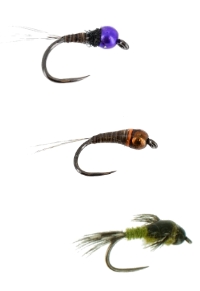Beaverhead River
The Beaverhead river, or the Beaver Ditch as the locals call it, is well known for its abundance of big trout. The Browns and Rainbows here average a solid 18 inches. Twenty plus inch fish are not uncommon for the Beaverhead, and are almost expected every time you fish this river. By nature, it is a narrow brushy tailwater fishery, with lots of deep undercut banks and great riffle water. The water here comes out of Clark Canyon Reservoir and therefore stays cool all year round. The trout here are big and strong, and fishing with 2X-4X leaders are the norm. While it may not be the most scenic river by Montana standards, it probably has the biggest trout per square mile than anywhere else in the state. The Beaverhead flows for over fifty miles before joining the Big Hole River.
The upper Beaverhead from Clark Canyon down to the Barretts Diversion Dam (approximately 12 miles) is by far the most popular section of river. Large rainbows and an over abundance of big browns flourish here, giving anglers an opporitunity to land a fish of a lifetime with every cast. The river here is narrow and wanders through a series of sharp turns making it kind of hard to drift, unless your Tim Mosolf. Thick willows and cottonwoods line the banks which makes casting very difficult. Wading can also be difficult because of the steep banks and overhanging brush. And, depending on flows, there can be a pretty swift current that can take you off your feet. Basically what we're saying is, floating is the easiest and most productive way to fish this section. Interstate 15 follows the upper river from Clark Canyon Dam down past Barretts to the town of Dillon.
At the Barretts Diversion Dam, a significant amount of water is removed from the lower Beaverhead, mainly for irrigation and potato farming purposes. From the diversion dam to Dillon, the river tends to warm up faster with the increased distance from the cold outflow at Clark Canyon Dam. Surprisingly though, this area does hold a good number of quality brown trout along with a few rainbows. Wade fishing this lower section of the river is much easier and is more popular for anglers who choose to fish without a guide. For anglers looking to catch a monster brown trout, fishing this area at night with a mouse fly is highly recommended.
Downstream of Dillon, the Beaverhead is not nearly as productive. Although it does hold a decent number of trout, the river here is hard to access. The water also starts to warm rather quickly down here. One thing that always remains cold in Dillon is the beer served at Max Last Cast. When you get done fishing for the day, make sure to stop in here for a cold one.
Beaverhead bugs include Blue-winged Olives, Pale Morning Duns, caddis, tricos, stoneflies, and craneflies. The stoneflies that hatch include the large golden stones and small yellow sallies. Caddis also come in a variety of colors although black and tan seem to be the two most predominant. Dry fly fishing can be exceptionally good here during the trico hatch. Streamers are also extremely effective on this river, but mainly nymphing is the name of the game. A popular way to nymph fish this river is by a method similar to Czech nymphing. By putting your weight at the end of your leader with your flies hanging somehwere above it, you will be able to keep your flies out of the moss along the river bottom. You will also be able to maintain direct contact with your flies, therfore resulting in more hook-ups. It is an absolutely deadly technique on this river.



